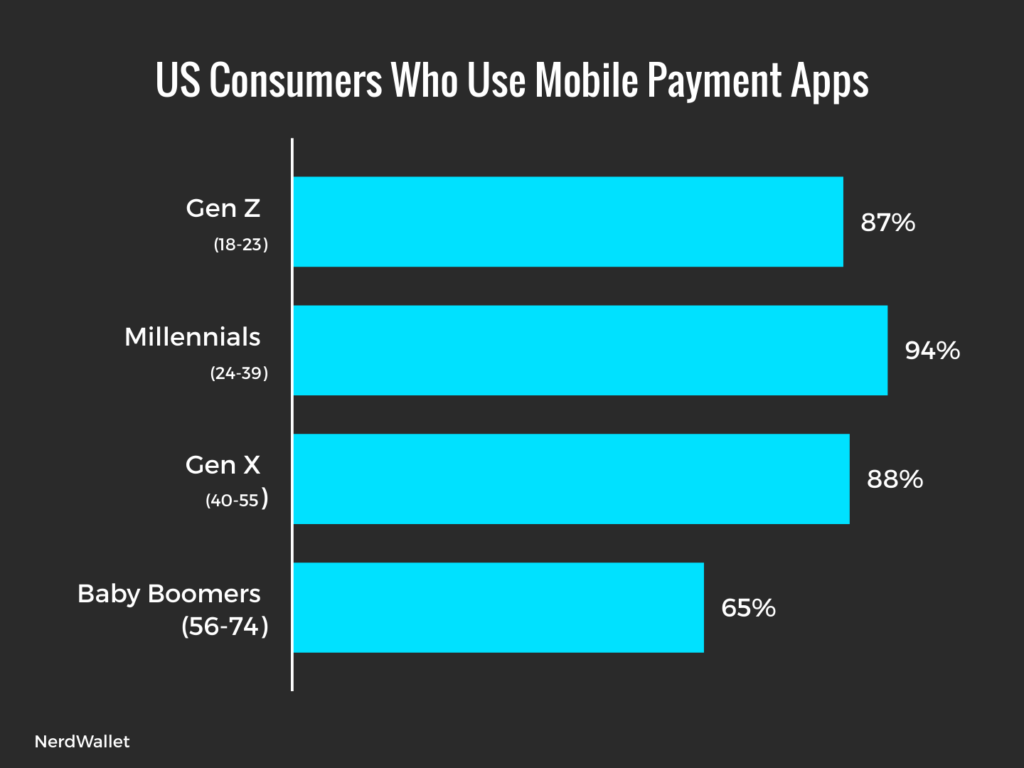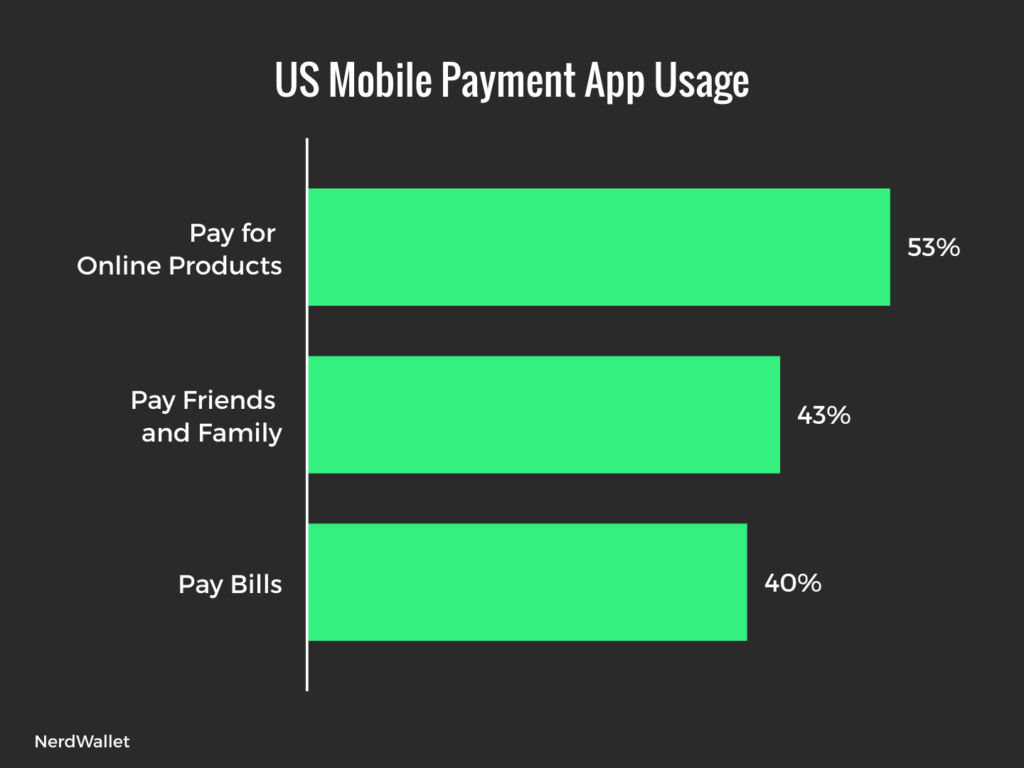Companies that Traditionally Relied on Cards Must Accept Mobile Payments or Risk Being Left Behind
Table of Contents
US consumers are more eager than ever for merchants to accept mobile payments, ewallets and other alternative payment methods. Merchants that enable customers to pay with their preferred payment methods will outperform those that rely exclusively on card-based payments.
According to Forrester, 11% of Americans Have Used Digital Payment Methods for the First Time Since the Beginning of the COVID-19 Pandemic1
US mobile payment marketshare is on the rise. The percent of Americans who use mobile payment apps and digital wallets in the US increased from 40% to 60% in just 3 short years between 2015 and 2018.2
Growing adoption and acceptance of mobile payments and digital wallets like Apple Pay, Google Pay and Samsung Pay are transforming an industry dominated by credit and debit cards. As more US merchants take their retail businesses online, mobile payment usage in the US will only accelerate.
Which Americans Use Mobile Payments?

Factors Influencing US Mobile Payment Adoption
1. Speed and Convenience through Real-Time Payments and Same-Day ACH Payments
The US ACH Payment network provides both businesses and individuals with the ability to quickly make and receive payments, removing uncertainties about actual account balances and making transactions faster and more convenient.
2. Confidence in Mobile Payment Security
Ensuring that payments are secure is essential to maintaining Mobile Payment growth. 42% of Americans who don’t use mobile payments list security as their top concern.3 A study by the Pew Research Center found that a majority of US consumers view cards as being more secure than mobile payments, with protections against loss of funds being a top concern.4

Ready to Accept Mobile Payments in the US?
Quickly add ewallets and mobile payments to your checkout experiences with Rapyd Collect
Peer-to-Peer Payments (P2P) Are Skyrocketing in Popularity
According to Forbes5, at the end of 2018, there were more than 80 million mobile phone P2P payments users in the US. Venmo and Zelle make up the lion’s share of these transactions. As consumers become more accustomed to the convenience of real-time bank transfers from apps on their mobile devices, they will begin to expect this same level of convenience from online and brick-and-mortar retailers.
Omnichannel shopping experiences are accelerating as a result of the coronavirus pandemic. This creates an opportunity for retailers to use digital payment methods like Venmo to bridge the gap between in-person and online shopping. Consumers can visit stores, look at products and try on clothes. The merchants can enable QR code payments to allow customers to purchase instantly with a mobile device, removing the need to stand in long lines and interact with clerks.
How Do Americans Use Mobile Payments?

Businesses Must Move Quickly to Adopt US Mobile Payments
The current transformation of the payments industry is similar to the evolution of downloadable media that rendered the video rental business obsolete. Rather than the gradual evolution of the previous decade, the next decade will boast rapid fintech developments that leapfrog legacy models. Already, 29% of US consumers say they want to pay with their smartphones all the time.6
Evolving US Payment Technologies to Watch
Push Payments
Peer to peer (P2P) money transfer apps like Venmo, which are powered by push payments, are already popular among Americans. Instead of requesting authorization to “pull” funds from a customer’s account, a P2P transaction “pushes” money from one user’s account to another. Innovators are beginning to use this technology to push payments in B2C and B2B settings, such as paying temporary employees or those working in gig economies like food delivery services via reloadable cards.
Proximity Mobile Payments
Nearfield Communications (NFC) technology is already in play in the US, enabling contactless, in-store transactions via mobile phones and chip cards. QR codes work similarly but are useful both in proximity mobile payments in-store, and in remote mobile payments that take place via mobile wallets online. QR codes haven’t achieved much traction in the US yet, but they will take a more prominent role in transactions moving forward. New US smartphones can automatically detect and read QR codes. The technology is already being used in US restaurants and stores as a way to limit in-person interactions and support social distancing efforts.
Digital Wallet Apps
Apple Pay, Android Pay and other eWallets in the US aren’t new, but the ability to use them without linking a bank account or credit card is an emerging trend to watch. Apple Cash, launched in 2019, works in-store, online, and as a P2P transfer app. It’s basically an Apple-branded virtual debit card allowing the user to load funds from a linked debit card, bank account or simply by receiving a funds transfer from another user. Apple Cash only works on Apple products, which may limit adoption. However, the ability to use one app for both P2P and in-store cash payments could lead to rapid adoption.
Super Apps
As dot-com giants in the US seek to differentiate themselves and capture more users by expanding into new industry segments, partnerships and acquisitions could give way to the rise of super apps in the United States. Super apps like China’s WeChat Pay and Alipay aren’t just popular payment platforms. They also function as social platforms, travel booking agencies, food delivery services, rideshare apps and more. Instead of collecting multiple apps for each type of activity, super app users can do it all on one platform, with a seamless user experience.
5G Communications
The US is racing to become a world leader in 5G. As 5G communications infrastructure becomes more widespread, sales via mobile devices will grow due to faster and more convenient shopping experiences. This will drive the adoption of mobile payment solutions as well.
Lots of Room to Grow
The United States is the second-largest ecommerce market in the world. Yet online shopping in the U.S. accounts for just 8.9% of overall retail sales. And mobile commerce is just 38% of the overall ecommerce market. Sales are projected to grow by at least 16% by 20217 and double-digit growth could easily be sustained for years—powered by rising smartphone adoption by older consumers and increasing adoption of mobile commerce and mobile payment apps by younger demographics.

Download Rapyd’s Guide to the Fastest Growing Local Payment Methods for 2020
Sources:
- Forrester Analytics Consumer Technographics COVID-19 Survey 1, 2020
- https://www.frbatlanta.org/-/media/documents/banking/consumer-payments/survey-of-consumer-payment-choice/2018/2018-survey-of-consumer-payment-choice.pdf
- https://www.nerdwallet.com/blog/banking/mobile-payment-app-survey/
- https://www.pewtrusts.org/en/research-and-analysis/issue-briefs/2019/10/are-americans-embracing-mobile-payments
- https://www.forbes.com/sites/donnafuscaldo/2019/08/23/heres-an-area-of-digital-payments-thats-booming-p2p-payments/#117882c55677
- https://www.statista.com/topics/982/mobile-payments/
- https://www.jpmorgan.com/merchant-services/insights/reports/united-states
Subscribe Via Email
Thank You!
You’ve Been Subscribed.



